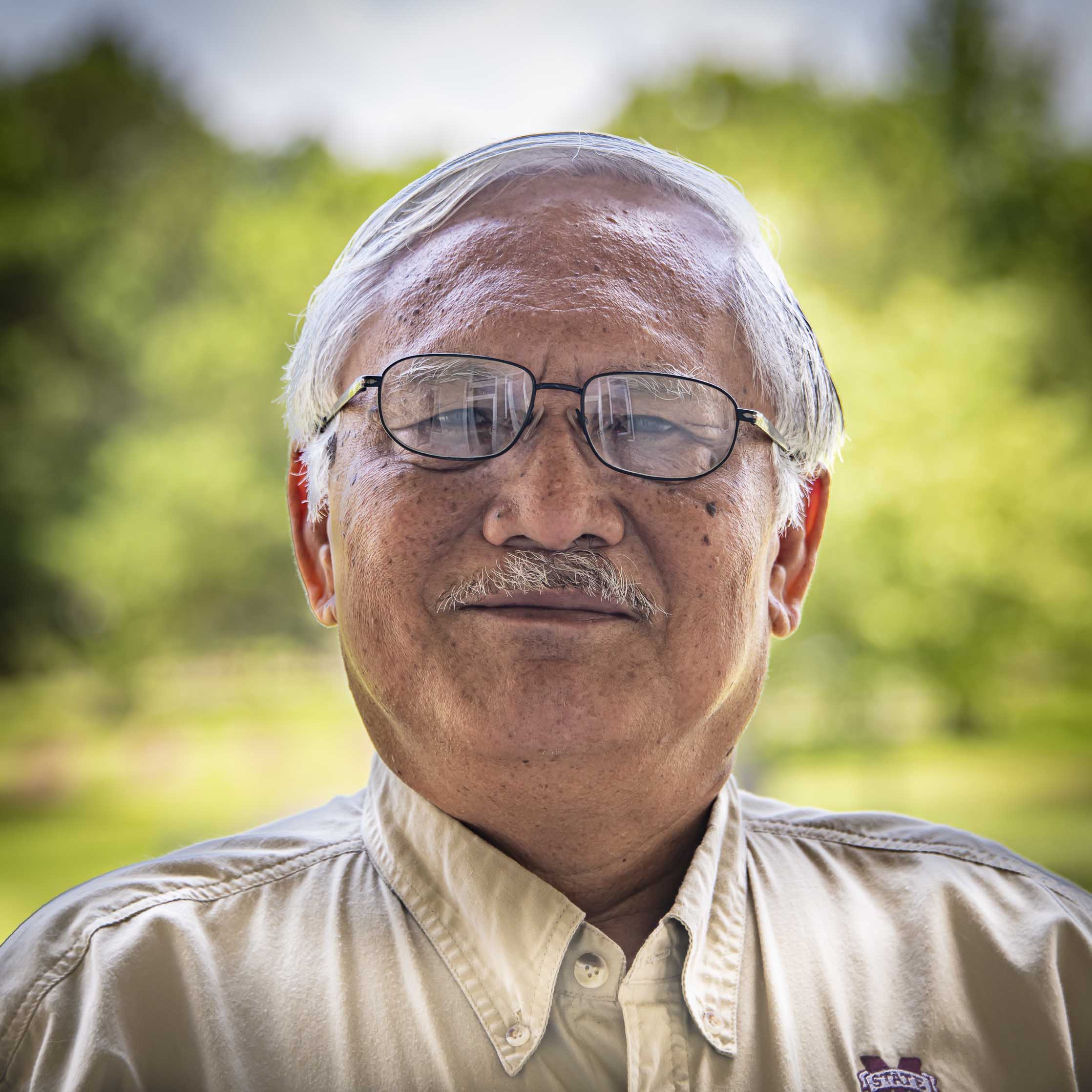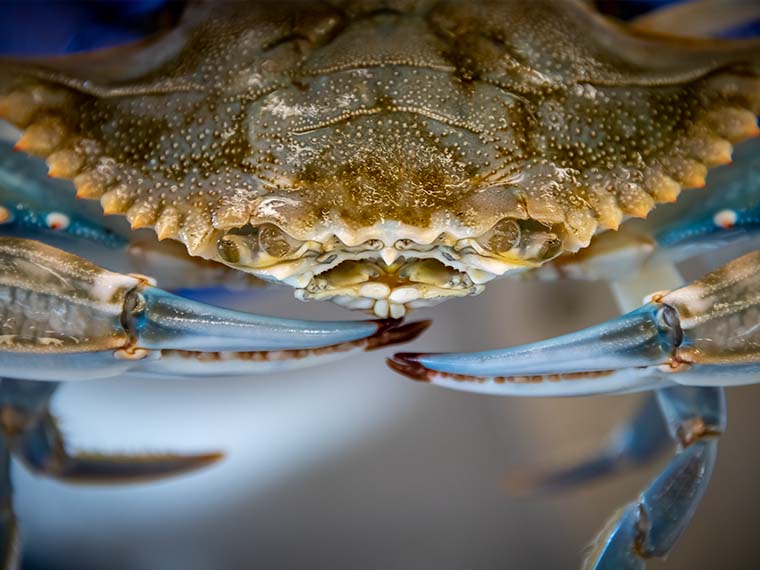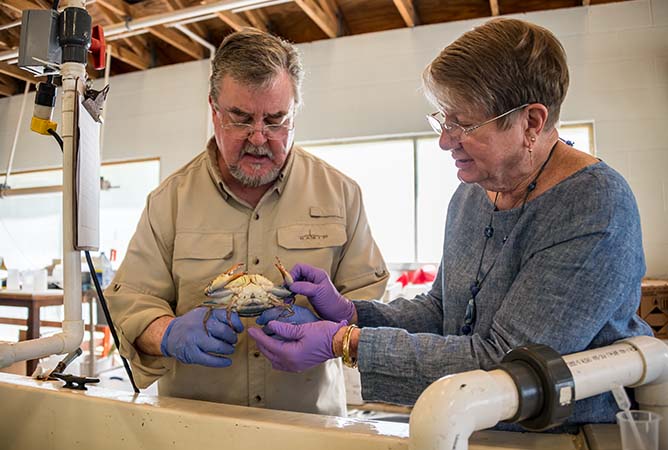The information presented on this page may be dated. It may refer to situations which have changed or people who are no longer affiliated with the university. It is archived as part of Mississippi State University's history.
Soft-shell crab, a popular seafood fare along the Gulf Coast, is seldom the catch of the day, because when the crustacean molts, sheds, peels, or busts its shell, it is in hiding. Blue crabs shed their hard, protective domicile to make way for a bigger shell. Many crab fishermen sort through their harvest to separate crabs about to molt, place them in a tank, and then patiently wait and watch until the transformation takes place to harvest soft-shell crabs, which sell for a premium compared to when they are encompassed in a hard-shell exterior.
In the wild, the crab prefers to molt in a secluded location to protect itself from predators. However, predators are just one of the dangers the crab faces in the Mississippi Sound. Environmental degradation, aquatic diseases, and natural and man-made disasters are all potential hazards for blue crab and oysters.
Hurricane Katrina in 2005 and the Deepwater Horizon Oil Spill in 2010 had significant impacts on the Gulf Coast and marine fisheries. However, lesser known events also disrupt the delicate aquatic ecosystem.
The opening of the Bonnet Carré Spillway, which diverts excess water from the Mississippi River to lower the river stages at New Orleans, also influences fisheries in the Mississippi Gulf. Constructed in 1931, the spillway has been opened 14 times in its 87 years. For the first time since its construction, the spillway was opened twice in 2019 and a total of three times over a 15-month period.
Each time the spillway opens, the potential devastation to Gulf oysters and crabs is significant, not only from the influx of fresh water but also because of increased potential for harmful algae blooms.
Dr. Ben Posadas, a Mississippi Agricultural and Forestry Experiment Station agricultural economist at the Coastal Research and Extension Center, understands the dilemma facing coastal fisheries. He has spent the last three decades studying economics and marketing of marine fisheries and aquaculture as well as the economics of natural and man-made disasters.
"Mississippi was in the process of restoring the public oyster reefs after Hurricane Katrina and the Deepwater Horizon Oil Spill when the Bonnet Carré Spillway was opened in summer 2011, resulting in massive oyster mortalities," Posadas said. "These mortalities impaired the recovery process."
The spillway opening is necessary to save lives and properties by diverting the waters of the mighty Mississippi River. Given the recent normalcy of the spillway opening-four times in the last three years-scientists in the Mississippi Agricultural and Forestry Experiment Station are working with numerous collaborators, funded largely by the Mississippi-Alabama Sea Grant Consortium, to find alternative methods to produce the coveted Gulf seafood staples including soft-shell blue crab.
One study that hopes to boost soft-shell blue crab production is in partnership with the University of Southern Mississippi's Thad Cochran Marine Aquaculture Center Gulf Coast Research Laboratory.
"Soft-shell blue crab production in Mississippi has fallen significantly since 1989 when the state harvested 20,000 pounds," Posadas said. "Now we are harvesting about 6,000 pounds with the entire Gulf region harvesting less than 200,000 pounds. The primary reasons for decline include habitat degradation due to freshwater inundation, aquatic disease, and low survival rates of juvenile crabs."
The team is developing the methodology and economic viability of growing blue crabs inland, away from the coast, in an effort to allow crab fishermen and others to capitalize on a lucrative market without the threats incurred in coastal waters.
"Soft-shell blue crabs sell for as much as $100 per dozen online," said Dr. Harriet Perry, senior scientist at the Gulf Coast Research Laboratory. "There is a market for small, appetizer-size soft-shell blue crabs, which are smaller than those fishermen are able to obtain from coastal waters due to harvest size restrictions. Restaurants are currently importing small crabs from other countries."
Perry has been developing the process to raise blue crabs in ponds at one of two blue crab hatcheries in the U.S. located at the Gulf Coast Research Laboratory. The process is laborious but promising.
Scientists accompany blue crab fisherman and comb through their catch in search of females who have bright yellow eggs, which the crustacean carries below the abdomen. The color indicates the eggs were recently laid. Three to four females are selected and taken to the lab where blood samples are drawn to ensure the crabs are free from disease.
"After clearing the female crabs of disease and parasites, we place them in a spawning tank for a week or less while the eggs develop. When the eggs hatch, the larvae are harvested and put into culture tanks," Perry said. "They stay in these tanks for about a month, going through seven molts. On the very last molt, called a metamorphic molt, they completely change shape and begin looking like lobsters with claws referred to as megalopae. At this time they are harvested and moved to long rectangular raceway tanks to grow out."
Once crabs are placed in the raceway tanks, salinity is reduced over a two- to three-week period, from 25 parts-per-thousand to three parts-per-thousand.
"Crabs are resilient and can survive at lower salinity levels," Perry said. "Our goal is to decrease the salinity over time so that when crabs are ready to be placed in ponds, creating artificial saltwater will cost less for the producer."
When the crabs grow to about the size of an inch and half, they are moved to quarter acre ponds at the Mississippi Department of Marine Resources's Lyman Aquaculture Center. Crabs are fed for about three weeks and are then harvested when three to four inches in length, the perfect appetizer size.
Harvesting the blue crabs at just the right time can be tricky. The crabs need to be close to molting to be harvested and placed in a tank to complete the molt cycle. Once the crabs molt, they must be removed from the water to be sold as soft-shell crabs. Molted crabs will remain soft for only a few hours, a small window to move the crab out of the water to prevent shell hardening.
Scientists at the Gulf Coast Research Laboratory are still developing the methodology to raise and harvest the crabs, including increasing survivability, which is currently at 25 percent.
Posadas was brought into the project to determine the economic viability of the new venture.
"The technology is promising and the cost to create artificial seawater has declined significantly," Posadas said. "My job is to determine if it is an economically-viable enterprise for farmers. This includes calculating the cost of the initial investment and ownership, the survival rate of crabs, and the market price growers receive for harvested crabs."
Posadas added that it is an exciting project to be involved in, one that could ultimately provide a new revenue stream for fishermen and farmers. While the Gulf Coast Research Laboratory has been working on blue crab production for some time, the economic assessment is a new component in the process, but an important one. Before farmers take the plunge, scientists want to ensure it is a worthwhile venture.
"Ultimately, my job is to help Mississippi fishermen and farmers remain profitable. The price for soft-shell blue crabs has increased significantly, illustrating a demand for the delicacy. Being able to grow soft-shell blue crabs in artificial saltwater ponds would create a niche market with harvest up to three times each year," Posadas said.
Mississippi's seafood industry contributes significantly to the state's bottom line, with income from the Mississippi seafood industry estimated at $465.4 million in four main sectors. Seafood retailing, which includes fish and seafood markets and restaurants, contributes the bulk of revenue at over 43 percent; seafood processing adds 29.6 percent; commercial harvesting accounts for 23 percent; and wholesale markets represent a little over four percent. With nearly 10,000 hardworking Mississippians employed directly or indirectly in the seafood industry, MAFES researchers are working to ensure that the salt life, while laborious and uncertain, remains the best life.
Ultimately, my job is to help Mississippi fishermen and farmers remain profitable. The price for soft-shell blue crabs has increased significantly, illustrating a demand for the delicacy. Being able to grow soft-shell blue crabs in artificial saltwater ponds would create a niche market with harvest up to three times each year.
Dr. Ben Posadas
Behind the Science

Ben Posadas
Associate Extension/Research Professor
Education: B.S., Business Administration (Economics), Mindanao State University; M.A., Economics, Ateneo de Manila University; Ph.D., Agricultural Economics, Mississippi State University
Years At MSU: 29
Focus: Economics of marine fisheries and aquaculture, horticulture, and coastal hazards
Passion At Work: Provide horticultural and marine economic information to coastal households, businesses, communities, and state and federal regulatory agencies.


